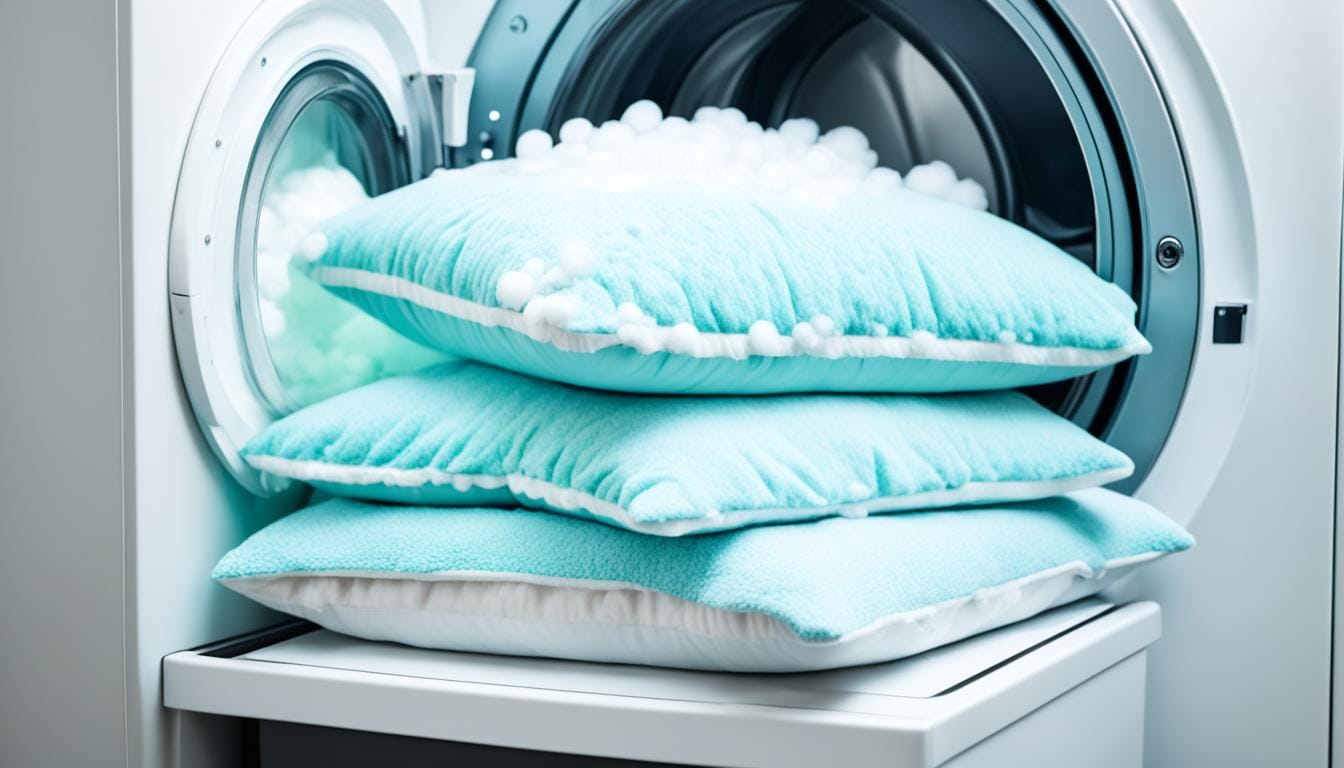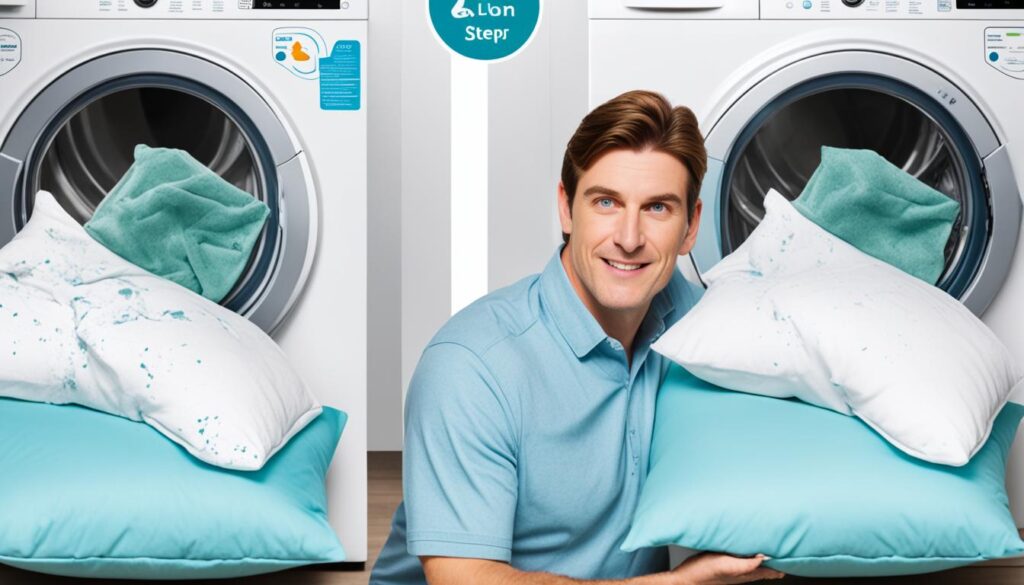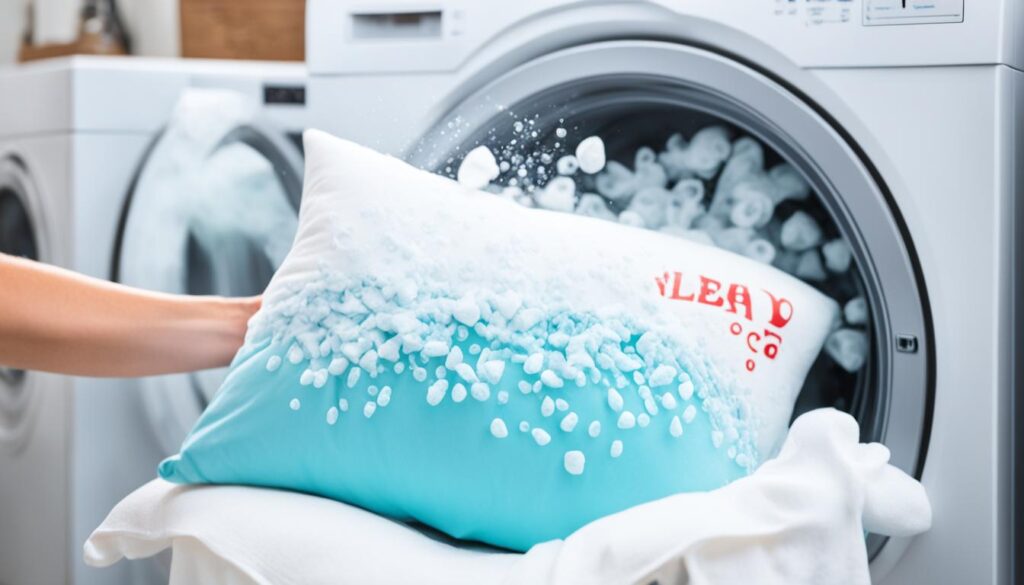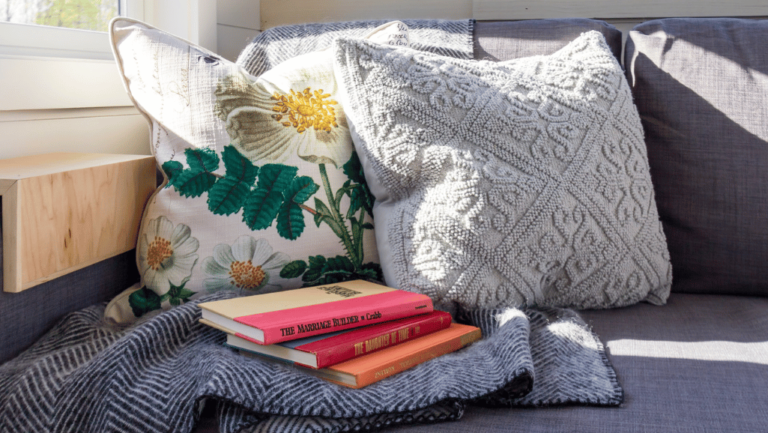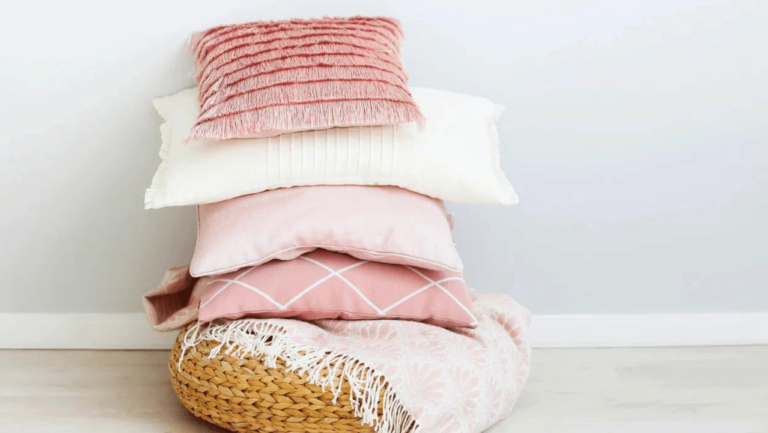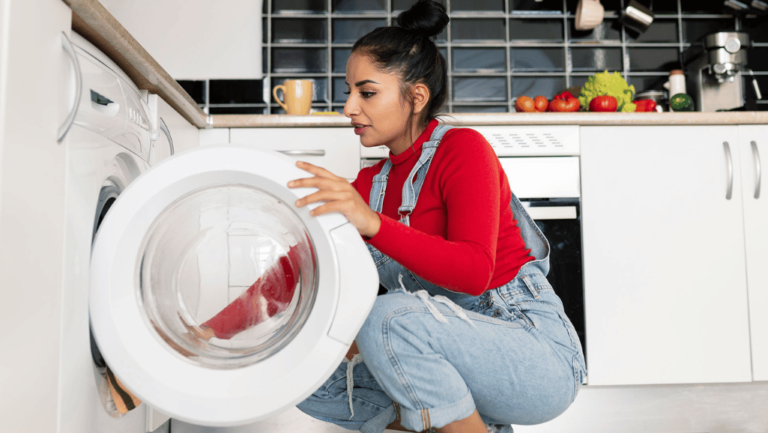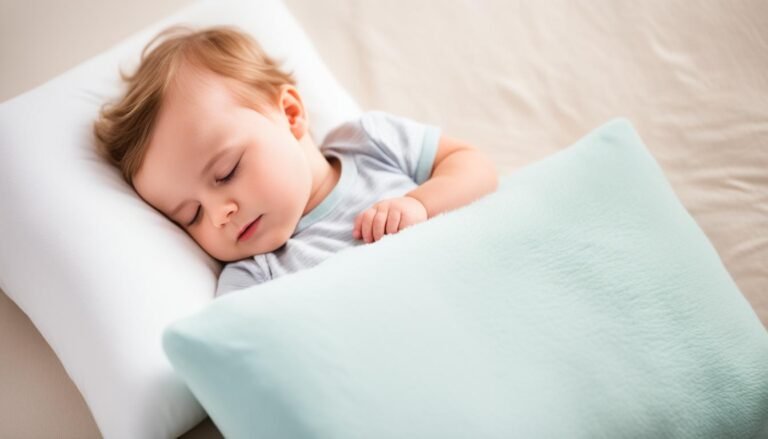Pillows are a big part of bedding. They gather dead skin and dust mites, so they need frequent cleaning. Washing them in the machine keeps things hygienic. It’s a drummed-in lesson from the cleaning experts at AspenClean and the American Cleaning Institute.
Regular care for your pillows is a must for them to stay clean and comfy. Kathy Cohoon from Two Maids suggests washing pillows filled with cotton or feathers every three to six months.
Foam and latex pillows can’t go in the washing machine. For these, gentle hand-washing in a bathtub with mild soap is best. Warm water does the trick.
It’s also good to wash two pillows at the same time. This makes sure your machine stays balanced. Adding natural detergent and a bit of white vinegar can boost the clean. Remember, after washing, gently dry by squeezing to remove extra water. Then, use a low dryer temperature and dryer balls to protect the filling. This helps keep your pillows looking as good as new.
Keeping your pillows clean makes them last longer. It also helps you sleep in a healthier space.
Key Takeaways
- Pillows should be washed every three to six months.
- Non-machine-washable pillows, like foam and latex, need hand-washing.
- Wash two pillows at once to maintain washing machine balance.
- Use low heat settings and dryer balls for effective drying without fill damage.
- Cleaning pillows helps remove dead skin and dust mites, contributing to overall hygiene.
Why is Washing Your Pillows Important?
Keeping your pillows clean is crucial for a healthy sleep. They gather dust, skin cells, and other allergens. These can affect your health and how well you sleep. Knowing this helps keep you healthy and happy.
Accumulation of Dust and Skin Cells
Pillows are where dust, skin cells, and dust mites hang out. It’s important to wash your pillows often. Brian Sansoni from the American Cleaning Institute suggests doing this every three to six months.
Impact on Sleep Quality
Having clean pillows leads to better sleep. They make sure you’re sleeping on a clean surface without allergens. Alicia Sokolowski from AspenClean adds that good pillow washing is key to avoiding breathing problems and disturbances in your sleep.
Recommendations from Experts
Experts say to stick to a pillow washing routine. Sokolowski suggests using a washing machine for most pillows, but hand wash memory foam and latex ones. Doing this will keep your pillows fresh and your sleep healthier.
How Often Should You Wash Your Pillows?
Understanding pillow maintenance is key to a clean sleep space. It’s best to wash your pillows every three to six months. Brian Sansoni from the American Cleaning Institute says regular washing is crucial for a clean bed.
The care of your pillows depends on the kind you have. Down feather pillows can go in the machine with cold water. But, polyester pillows should be washed in warm water with less detergent. Use about one tablespoon.
For special pillows, like body or throw pillows, clean them every three to six months, depending on how much you use them. However, latex or memory foam pillows are best cleaned by hand.
Fluff your pillows daily to keep their shape and freshness. Airing them out monthly outdoors helps with smells and makes them last longer. Always check the care label. Some pillows can’t go in the machine and need special cleaning.
| Type of Pillow | Washing Frequency | Care Instructions |
|---|---|---|
| General Pillows | Every 3-6 months | Machine wash warm water and less detergent |
| Down Feather | Every 3-6 months | Machine wash with cool water |
| Specialty Pillows (e.g., Body, Throw) | Every 3-6 months | Adjust according to usage |
| Latex/Memo Foam | As necessary | Hand wash to prevent foam breakdown |
It’s wise to get new pillows every one to two years for a healthy sleep. You should also take good care of your pillows. This means using protectors and following the care instructions.
Stay on top of keeping your pillows clean for a better night’s rest.
How Do You Wash Pillows in the Washer?
Maintaining a clean sleeping spot means looking after your pillows well. Many wonder: how should you clean your pillows in the washer? Let’s tackle this step by step.
Checking the Care Label
The first move to washing pillows right is to read the care label. Each pillow has unique rules for care. Some are fine in the washer, but items like memory foam need different care. Always check to prevent problems.
Pre-Treating Stains
Start by treating any visible spots on the pillows. A bit of natural detergent can do the trick. This step makes sure your pillows come out clean. Good pillow washing starts with managing stains well.
Choosing the Right Settings
For the best wash, choose a gentle cycle and cold water. This keeps the pillow fill from bunching and cleans it gently. It helps to wash two pillows together and ensure the machine doesn’t get off-balance.
| Pillow Type | Washing Method | Frequency | Additional Tips |
|---|---|---|---|
| Polyester | Machine Washable | Every 3-6 months | Use tennis balls for fluffing |
| Down & Feather | Machine Washable | Every 6 months | Gentle cycle, low heat |
| Memory Foam & Latex | Not Machine Washable | Every 3 months (deep clean) | Hand-wash only |
| Wool | Machine Washable | Every 6 months | Use wool-specific detergent |
Now you know the right way to wash your pillows. Remember, focus on the care labels, get rid of stains early, and pick the best wash settings. Don’t forget, fast drying and a little upkeep now and then will help keep your pillows fresh. This way, you create a healthy sleeping space.
Best Way to Wash Different Types of Pillows
It’s key to wash pillows right so they stay clean and comfy for years. Each type of pillow needs a special way to clean it. Know the best way to wash pillows to make them last longer and stay soft.
Down and Feather Pillows
Washing feather pillows means you should use a gentle cycle with warm water. Add a little mild detergent. Wash two together to keep your machine balanced. Use a low or no-heat setting to dry the pillows. Toss in dryer balls to keep them fluffy. Do this every six months for the best care.
Fiberfill Pillows
Fiberfill pillows, made from synthetic materials, follow a similar routine. Wash on the gentle cycle with mild detergent in warm water. Dry on low heat with dryer balls. Cleaning them every three to six months helps maintain their quality.
Polyester Pillows
Polyester pillows can usually go in the machine, but check the tag first. Follow the pillow care instructions from the maker. Wash on the gentle cycle with cool water. Keep your machine balanced by washing two at a time. Dry on a low or no-heat setting with dryer balls. Washing them every three to six months keeps them looking and feeling new.
It’s essential to know how to clean each type of pillow. This knowledge helps you keep your pillows fresh and comfy. Keeping your pillows clean is important for a good night’s sleep and overall health.
Washing Memory Foam and Latex Pillows
Memory foam and latex pillows need special care to clean them. They are not good in the washing machine. You should clean them by hand and only at dirty spots. This way, they stay nice for longer.
Hand-Washing Tips
To clean memory foam pillows well, you should do it by hand. Fill a tub with warm water and a little gentle soap. Put the pillow in and gently press it to let the soapy water in. Don’t twist or squeeze the pillow too hard. Then, rinse it well to get rid of the soap.
Spot-Cleaning Techniques
Sometimes, a pillow just needs a little spot-cleaning. For small stains, use a mild soap and water mix. Dab this on with a cloth. Clean the spots gently without making the pillow too wet. This helps the pillow dry faster and stay mold-free.
By following these tips for washing pillows, your memory foam and latex pillows will last longer. After cleaning, make sure the pillow dries completely in the air. It usually takes about a day. Turn the pillow now and then for an even dry. Also, use a cover and change the pillowcase often to keep it clean.
Pillow Maintenance Between Washes
Taking care of your pillows between washes is very important. It helps keep them clean and last longer. Following some simple steps can make your pillows stay in great shape. This means you get better sleep and keep things clean.
Using Pillow Protectors
Pillow protectors are like shields against dust mites and bacteria. They keep your pillows cleaner. With protectors, you won’t have to wash your pillows as often. We should wash the protectors weekly for the best cleanliness. This keeps your pillows fresh and in good shape.
Air-Drying Methods
Drying pillows in the air is a good way to remove moisture. It also stops mildew from growing. Place your pillows outside if you can, in a sunny and breezy spot. Oft used pillows should get fresh air every few weeks to stay pleasant.
Avoiding Common Mistakes
- Avoid eating in bed: It can make your bed dirty and attract bugs.
- Keep pets away: Pets bring in dirt and allergens, needing more pillow cleaning.
- Replace pillowcases after you are sick: It stops the spread of germs.
- Store pillows in a cool, dry place: This keeps them in good condition for longer.
These simple tips will keep your pillows comfy and clean. They help you sleep better and stay healthy.
Drying Your Pillows Properly
Drying your pillows right after washing is key for freshness and longevity. Incorrect drying can cause mold or misshape. It’s crucial to follow correct pillow care instructions and use the best drying techniques to keep them like new.
Using a Dryer
Dry pillows that are safe for the machine on low heat. Tossing in tennis balls or dryer balls helps keep them fluffy. Make sure to check often for even drying. This stops them from smelling and prevents mildew.
Air-Drying Techniques
Air-drying is a great way to care for your pillows. Place them on a towel where the sun shines and air flows. Flip them now and then for drying all around. For memory foam, avoid heat to stay safe from fires.
Tips to Maintain Shape
Keeping pillows’ shape during drying is essential. Fluff and turn them regularly to keep their form. Pillow protectors are also great for keeping them clean and dry. Remember, make sure they’re fully dry before using to maintain quality.
Preventing Odors in Pillows
Keeping your pillows fresh is key for a good night’s sleep. There are simple ways to keep your pillows smelling nice and clean. This helps maintain a healthy sleep environment.
Using Baking Soda
Baking soda is a great natural odor fighter. Just sprinkle some on your pillows. Let it sit for a couple of hours or overnight. Then, shake off the excess and vacuum. This method is a simple way to keep pillows fresh between washes.
Sunlight and Fresh Air
Direct sunlight and fresh air are the best fresheners. Sunlight kills mold and bacteria, which cause bad smells. Put your pillows outside on a sunny day. A few hours of airing can make them smell great again.
Regular Maintenance Tips
Keeping pillows clean is easy with a few regular steps. Air them out often and use protectors. Also, wash your pillowcases every week. Doing these things will keep your pillows fresh and comfy for longer.
Pillow Replacement Guidelines
Pillows should be replaced every one and a half to two years for a clean sleep. They get dirty from our skin and collect bacteria. This can harm our health and how well we sleep. Even if you wash your pillows, they still wear out over time.
According to Kathy Cohoon from Two Maids, we use pillows every day. To avoid bacteria and dust mites, she advises changing them often. Latex and memory foam pillows last longer with good care. Not all pillows can go in the washing machine. So, it’s best to clean them as their care labels suggest.
- Pillows with cotton, feather, down, or fiberfill can go in the wash. Brian Sansoni recommends cleaning them every three to six months. Use warm water and the gentle cycle to keep them fresh.
- Memory foam and latex pillows need special care to stay in shape. You should clean these by hand with a gentle detergent. Then, make sure they dry completely to avoid mold.
To keep your pillows clean and comfy, follow these tips:
| Pillow Type | Cleaning Method | Replacement Frequency |
|---|---|---|
| Memory Foam | Hand-Wash | 2-3 Years |
| Latex | Hand-Wash | 2-3 Years |
| Cotton | Machine Wash | 1.5-2 Years |
| Feathers/Down | Machine Wash | 1.5-2 Years |
Groups like the Asthma and Allergy Foundation of America say to change your pillows to lower allergen exposure. Cleaning pillows and replacing them on time keeps your sleep area healthy. It ensures you sleep well and stay well for years to come.
Conclusion
Washing pillows often is key for a tidy, healthy, and cozy place to sleep. Different types of pillows need different cleaning steps. But, some basic steps are always important. These include reading the label, treating stains before washing, picking the right setting on your washer, and drying in the best way.
Memory foam and latex pillows should be cleaned by hand. On the other hand, machine washing is fine for down and polyester pillows. If you use a top-loading washer with no central spinning mechanism, it’s better for your pillows.
To keep your pillows fresh in-between washes, using pillow protectors is smart. You should also air them outside sometimes to remove dust. Also, make sure to follow pillow care guidelines strictly.
When drying, putting in a few dryer balls or tennis balls can help your pillow stay fluffy. Use a gentle laundry detergent that doesn’t have any dyes or strong scents. This will help prevent any stains.
Pillows need to be replaced every one and a half to two years for health and comfort. Washing two pillows together usually cleans them better. With these tips, you can keep your pillows and bed fresh. Plus, your sleep space will be a healthier place.

